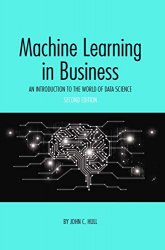 Название: Machine Learning in Business: An Introduction to the World of Data Science Second Edition
Название: Machine Learning in Business: An Introduction to the World of Data Science Second EditionАвтор: John Hull
Издательство: School of Management University of Toronto
Год: 2020
Формат: true pdf/fb2
Страниц: 274
Размер: 10.5 Mb
Язык: English
This book is for business executives and students who want to learn about the tools used in machine learning. In creating the second edition, John Hull has continued to improve his material and added three new chapters. The book explains the most popular algorithms clearly and succinctly without using calculus or matrix/vector algebra. The focus is on business applications. There are many illustrative examples. These include assessing the risk of a country for international investment, predicting the value of real estate, and classifying retail loans as acceptable or unacceptable. Data, worksheets, and Python code for the examples is on the author's website. A complete set of PowerPoint slides that can be used by instructors is also on the website. The opening chapter reviews different types of machine learning models. It explains the role of the training data set, the validation data set, and the test data set. It also explains the issues involved in cleaning data and reviews Bayes’ theorem. Chapter 2 is devoted to unsupervised learning. It explains the k-means algorithm and alternative approaches to clustering. It also covers principal components analysis. Chapter 3 explains linear and logistic regression. It covers regularization using Ridge, Lasso, and Elastic Net. Chapter 4 covers decision trees. It includes a discussion of the naive Bayes classifier, random forests, and other ensemble methods. Chapter 5, explains how the SVM approach can be used for both linear and non-linear classification as well as for the prediction of a continuous variable. Chapter 6 is devoted to neural networks. It includes a discussion of the gradient descent algorithm, backpropagation, stopping rules, autoencoders, convolutional neural networks, and recurrent neural networks. Chapter 7 explains reinforcement learning using two games as examples. It covers Q-learning and deep Q-learning, and discusses applications. Chapter 8 covers natural language processing. It discusses how the algorithms introduced in the book can be used for sentiment analysis, language translation and information retrieval. Chapter 9 is concerned with model interpretability. It discusses the importance of making models understandable and the procedures that can be used for both white-box and black-box models. Chapter 10 explains two applications involving derivatives that the author has been involved in. The final chapter focuses on issues for society. The topics covered include data privacy, biases, ethical considerations, legal issues, and adversarial machine learning. At the ends of chapters there are short concept questions to test the readers understanding of the material and longer exercises. Answers are at the end of the book. The book includes a glossary of terms and an index.